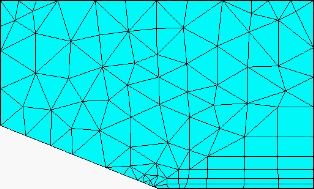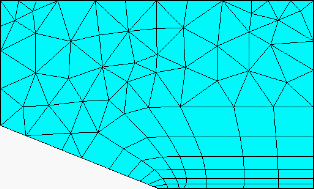The Maximum Angle control determines prism layer growth around angles and when prisms will adhere (project) to adjacent surfaces/walls. If the inflated mesh involves extruding from one surface and not its neighbor, and the angle between the two surfaces is less than the specified value, the prisms (sides) will adhere (project) to the adjacent wall. Valid values are from 90 to 180 (degrees). Typically, a value between 120 and 180 is desirable. The default is 140. Refer to the figures below for examples of maximum angle.
For 2D inflation, the Maximum Angle control determines whether an edge that is adjacent to an inflation edge can be imprinted with inflation mesh. If the angle between the two edges is smaller than the value of Maximum Angle, the inflation mesh will be imprinted on the adjacent edge. On the other hand, if the angle between the two edges is larger than the value of Maximum Angle, the inflation mesh will not be imprinted on the adjacent edge.
In Figure 61: Maximum Angle = 140, the angle between the planes is 158.2 (21.8) degrees. Since the maximum angle is less than the angle between the walls, the prism layers are capped with pyramids.
In Figure 62: Maximum Angle = 180, the maximum angle exceeds the separation angle between the surfaces, so the prism remains attached to the adjacent surface.




